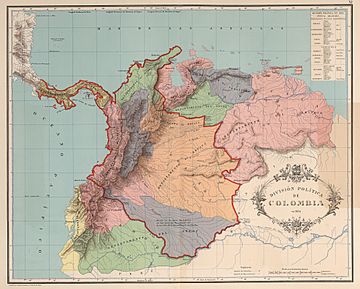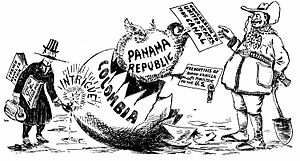Separation of Panama from Colombia facts for kids
Panama became an independent country on November 3, 1903. Before this, it was part of Colombia. Panama had first become free from Spain in 1821. At that time, it joined a large country called Gran Colombia, which included parts of today's Colombia, Venezuela, and Ecuador.

Panama was always loosely connected to the rest of Colombia. This was because it was far from the government in Bogotá and there was no easy way to travel overland through the Darién Gap. In 1840–41, Panama even had a short time as an independent republic under Tomás de Herrera.
After rejoining Colombia, Panama remained a province. However, there were often rebellions. A notable one was the Panama crisis of 1885, which involved the United States Navy and a response from the Chilean Navy.
Later, when people tried to build the Panama Canal, France first tried to dig a canal across Panama. They had an agreement with Colombia. But France faced many problems, including high costs and money issues, which stopped the project for ten years.
During this time, local groups who wanted Panama to be separate used the political problems of the Thousand Days' War to push for independence. When the United States wanted to take over the canal project, the Colombian government was difficult to work with. With help from a French businessman named Philippe-Jean Bunau-Varilla, Panama declared independence from Colombia. It then quickly made a deal with the U.S. to build the canal, known as the Hay–Bunau-Varilla Treaty.
The United States was the first country to officially recognize the new Republic of Panama. The United States Navy was sent to stop Colombia from trying to take back the land in the first days of the new country. Because the U.S. helped defend Panama and built the canal, it was given control over the land around the canal, called the Panama Canal Zone. This land was later given back to Panama under the Torrijos–Carter Treaties.
Many other countries quickly recognized Panama's independence. However, Colombia did not recognize it until 1909. This happened after Panama agreed to pay Colombia $500,000 to cover its share of old debts.
Contents
Panama's Early History
After Panama became free from Spain on November 28, 1821, it became part of the Republic of Gran Colombia. This large country included what is now Colombia, Venezuela, Panama, and most of Ecuador.
There was a big political fight between those who wanted a strong central government (centralists) and those who wanted local governments to have more power (federalists). This fight changed Panama's status many times. When the central government was strong, Panama was called the Department of the Isthmus. When local areas had more power, it was called the Sovereign State of Panama.
The 1885 Crisis
In 1846, Colombia and the United States signed a treaty called the Mallarino–Bidlack Treaty. This treaty said that the United States would keep "neutrality" in Panama. In return, the U.S. could use the travel routes across Panama.
In March 1885, Colombia moved many of its soldiers from Panama to fight rebels in other parts of the country. This made it easier for a rebellion to start in Panama. The United States Navy was sent to keep order, even though the 1846 treaty had different rules.
In 1885, the United States took control of the city of Colón, Panama. Chile, which had a very strong navy at the time, sent its warship Esmeralda to take control of Panama City. The captain of the Esmeralda was told to stop the United States from taking over Panama.
The Thousand Days' War
The Thousand Days' War (1899–1902) was a very damaging civil war in Colombia, including Panama. It was fought between the Liberal and Conservative Parties. The war ended with the signing of the Treaty of Wisconsin. However, a Liberal leader named Victoriano Lorenzo did not agree with the treaty and was killed on May 15, 1903.
On July 25, 1903, the office of a Panamanian newspaper called El Lápiz was attacked. This happened because the newspaper had published a detailed story about Victoriano Lorenzo's death and the protests in Panama. This event made Panamanian liberals lose trust in the Conservative government in Bogotá. They later joined the movement to separate from Colombia.
In 1903, the United States and Colombia tried to sign the Hay–Herrán Treaty to finish building the Panama Canal. But the Congress of Colombia rejected this treaty on August 12, 1903. After this, the United States decided to support the groups in Panama who wanted independence. This way, the U.S. could gain control over the canal project that France had started.
Panama Becomes Independent
A Panamanian politician named José Domingo De Obaldía was chosen to be the Governor of Panama. He was supported by the groups who wanted independence. Another politician, José Agustín Arango, started planning the revolution. These groups wanted to talk directly with the United States about building the Panama Canal because the Colombian government was not cooperating.
The group planning the separation included Arango, Dr. Manuel Amador Guerrero, General Nicanor de Obarrio, Ricardo Arias, Federico Boyd, Carlos Constantino Arosemena, Tomás Arias, and Manuel Espinosa Batista. Amador Guerrero went to the United States to get support for their plan. He also got help from important Panamanian liberal leaders and a military commander named Esteban Huertas.
With strong support, the independence movement planned for November 1903. However, rumors reached Colombia. The Colombian government thought that Nicaragua was planning to invade a part of northern Panama. So, the government sent soldiers from the Tiradores Battalion from Barranquilla. They told the commander to take over from Governor José Domingo de Obaldía and General Esteban Huertas, whom the government did not trust.
The Tiradores Battalion, led by Generals Juan Tovar and Ramón Amaya, arrived in the Panamanian city of Colón on the morning of November 3, 1903. They were delayed on their way to Panama City because the Panama Railway authorities, who supported the independence movement, helped slow them down. When they arrived in Panama City, the troops were put under the command of Col. Eliseo Torres. General Huertas, who commanded the Colombia Battalion in Panama, ordered the arrest of Tovar and his officers.
The Colombian gunboat Bogotá fired shells at Panama City on the night of November 3. This caused injuries and killed Mr. Wong Kong Yee from Hong Sang, China. He was the only person who died during the independence events.
A United States Navy gunboat, USS Nashville, commanded by Commander John Hubbard, also helped delay the Colombian troops in Colón. He kept saying that the "neutrality" of the railway had to be respected.
With the Colombian troops stopped, the Revolutionary Junta declared that Panama was separating and becoming independent. They called it the Republic of Panama. A naval group in the Bay of Panama was captured without a fight.
Demetrio H. Brid, the president of the Municipal Council of Panama, became the temporary President of Panama. On November 4, 1903, he appointed a Provisional Government Junta. This group governed the country until February 1904, when the Constituent National Convention was held. The convention elected Manuel Amador Guerrero as the first official president. News of Panama's separation from Colombia only reached Bogotá on November 6, 1903, because of a problem with the submarine cables.
How People Reacted
On November 13, 1903, the United States officially recognized the Republic of Panama. On November 18, 1903, the United States Secretary of State John Hay and Philippe-Jean Bunau-Varilla signed the Hay–Bunau-Varilla Treaty. No Panamanians signed the treaty, even though Bunau-Varilla was there as Panama's representative. He had helped the rebels financially, but he had not lived in Panama for 17 years before its independence and never returned. The Panamanian government and the United States Senate later approved the treaty.
Colombia's ambassador in Ecuador, Emiliano Isaza, knew about the situation in Panama but did not tell his government. He wanted to prevent a revolt in Bogotá. The Colombian government then sent a diplomatic group to Panama. They tried to make Panama change its mind. They suggested that if Panama reconsidered, the Colombian senate would approve the Hay–Herrán Treaty instead of the Hay–Bunau-Varilla Treaty. They even suggested making Panama City the capital of Colombia.
This group met on the ship USS Mayflower with the Panamanian group, which included Constantino Arosemena, Tomás Arias, and Eusebio A. Morales. The Panamanians rejected all proposals. Colombia then sent another group of important politicians, including General Rafael Reyes, Pedro Nel Ospina, Jorge Holguín, and Lucas Caballero. They met with the same Panamanian representatives and Carlos Antonio Mendoza, Nicanor de Obarrio, and Antonio Zubieta, but they could not agree on anything.
Panama's independence worried Chile. They were concerned about the growing power of the United States. Because of this, Chile worked hard to stop the United States from buying the Galápagos Islands or building a naval base there like Guantanamo Bay. Germany and Britain supported Chile in this effort.
Countries Recognizing Panama
Many countries quickly recognized Panama as an independent nation. The United States was the first, followed by France, China, and many others. Colombia was one of the last countries to recognize Panama's independence, doing so in 1909.
See also
 In Spanish: Separación de Panamá de Colombia para niños
In Spanish: Separación de Panamá de Colombia para niños


